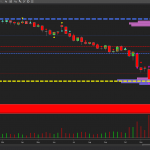The first step to successful trading is the identification of medium and the short-term trends. Traders who remain on the right side of the trend and use risk management principles usually end up earning profits. An equally important activity in the trading process is calculating the entry.
Many times, traders are afraid to pull the trigger in the optimal moment and miss a large part of the rally. As they see the markets move higher from the sidelines, the urge to buy keeps increasing and many times, they end up buying near the top.
To avoid such mistakes, it is important to devise an easy system for purchasing. Every trader wants to buy at the low and sell at the high, but that is easier said than done. Instead, traders should focus on capturing a major portion of the rally by taking the least possible risk. Let’s learn some easy strategies for doing this.
Trading in a range-bound market
Although the price action in a range-bound market is volatile and random, it can still be traded. If the ranges are too tight, it is better to sit on the sidelines instead of trying to trade choppy price action.

The larger number of touches both on the support and resistance of the range, the better it is to trade because the possibility of whipsaws are less. Usually, every range-bound action is followed by a strong bullish or bearish move. Hence when the trend changes, traders should alter their trading strategy accordingly.
How to buy in a bull market using moving averages
After a bull trend starts, the asset continues to make higher highs and higher lows. Traders who keep waiting to buy on a significant correction miss the bus. Therefore, when the trader identifies an upsloping 20-day exponential moving average and 50-day simple moving average, it is time to look for an entry opportunity.

After the trend is established, traders should wait for a low-risk opportunity to buy. In an uptrend, the 20-day EMA acts as a strong support. Therefore, traders can wait for the price to dip and rebound off the 20-day EMA before buying. This gives a low-risk buying opportunity as the stop-loss can be placed just below the 20-day EMA or the swing low.
In the above chart, ellipses are used to mark the points where traders could have purchased. The price dipped to the 20-day EMA on six occasions which could have been good entry points. However, on one of the trades, the stops could have hit.
On March 25, the price broke below the 20-day EMA and the swing low was made on March 16. This could have hit the stops of short-term traders. However, the bears could not sustain the price below the 20-day EMA because the bulls bought the dips to the 50-day SMA.
The price quickly rose above the 20-day EMA on March 27, indicating resumption of the uptrend. In such cases, traders can either buy on a close above the 20-day EMA or the most recent swing high because it signals that bulls are back in command.
Let’s investigate a few more examples.

This shows there is no fool-proof entry opportunity and traders should be willing to buy again at higher prices if the uptrend resumes.
In all three cases, the price took support close to the 50-day SMA and bounced back above the 20-day EMA. This was a signal to traders that the trend has resumed. This is generally a good entry point as the stop-loss is well defined and the profit potential is high. On all three occasions, the trade turned out to be profitable.


Moving averages as resistance in a downtrend
After the trend changes direction to a downtrend, the moving averages tend to act as points of resistance.

After the downtrend was established, there were two occasions when the price rose above the 50-day SMA. Note that before this happened, the RSI dipped close to the oversold territory, which may have attracted counter-trend traders.

Don’t waste time looking for the ‘perfect’ entry opportunity
Most times, the best entries also fail and the stop loss orders are hit. After experiencing a string of losses, novice traders often become discouraged and do not buy at higher levels as they wait to either buy at the same level their stops were hit or lower. Because of this, they miss a large part of the uptrend.
In a bull phase, traders should be ready to buy when the trend resumes. Treat each trade as a fresh one and do not be fixated on the profit or loss realized on the previous ones.
Each coin’s behavior is different, therefore traders should alter the periods of the moving averages to suit the coin and then devise entry points accordingly.







Leave A Comment